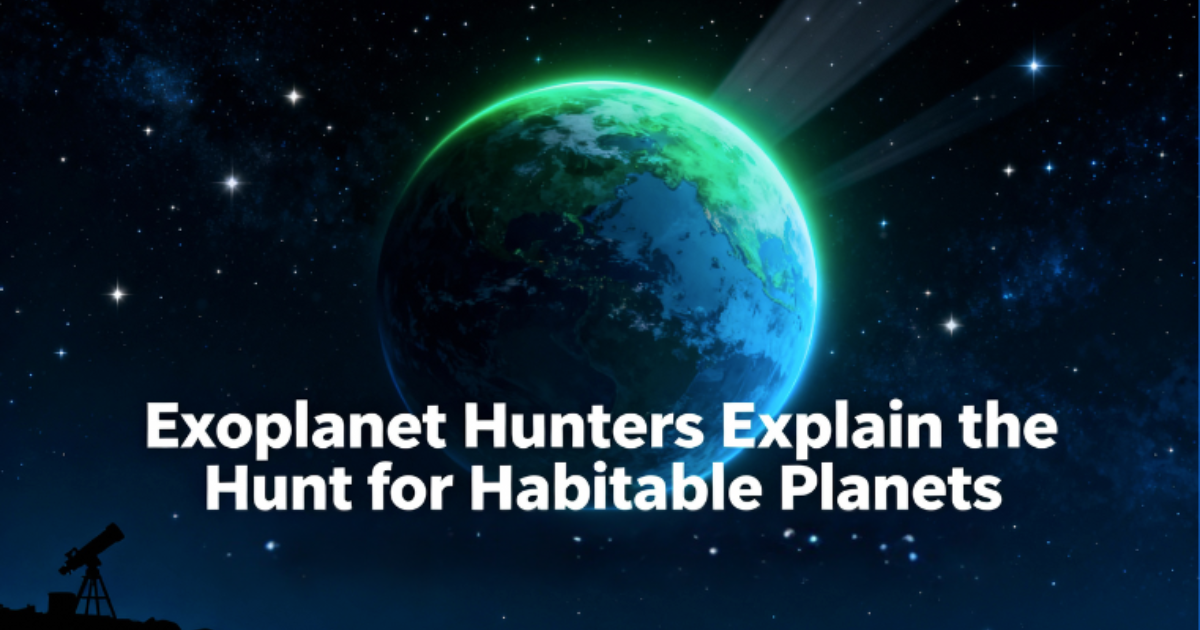Exoplanet Hunters Explain the Hunt for Habitable Planets
On October 6, 1995, at a scientific meeting in Florence, two Swiss astronomers, Michel Mayor and Didier Queloz, announced a monumental discovery that changed our understanding of the universe: they had detected the first exoplanet orbiting a star other than our Sun.
The star, 51 Pegasi, is about 50 light-years away. Its newly christened companion, 51 Pegasi b, was a huge surprise. Unlike anything described in textbooks, this gas giant, with a mass at least half that of Jupiter, orbited its star in just over four days. Its extreme proximity—20 times closer to its star than Earth is to the Sun—made its atmosphere a scorching furnace.
The discovery was made using Elodie, a spectrograph at the Haute-Provence observatory. This instrument analyzes starlight, revealing a “stellar barcode” of fine dark lines. Mayor and Queloz noticed this barcode on 51 Pegasi was shifting rhythmically every 4.23 days, a sign the star was being tugged by an unseen companion’s gravity. After careful analysis, they concluded the cause was a giant planet in a close orbit.
Their groundbreaking paper was published in Nature with the headline: “A planet in Pegasus?” The initial skepticism reflected in the question mark was due to the planet’s unusual location. At the time, there was no known scientific mechanism to explain how such a massive planet could form in such a fiery, close-in environment.
The Exoplanet Revolution
The discovery of 51 Pegasi b was the crack that opened the door to a flood of new discoveries. In the 30 years since, scientists have cataloged over 6,000 exoplanets and candidates, and their variety is astonishing. They have found ultra-hot Jupiters with orbits of less than a day, planets orbiting two stars like Tatooine, and strange “super-puff” gas giants that are larger than Jupiter but have only a fraction of its mass. They have also discovered chains of small rocky planets in tight orbits.
This revolution in astronomy led to Michel Mayor and Didier Queloz receiving a Nobel Prize in 2019. We now believe that most stars have planetary systems, yet we have still not found a system that truly resembles our own.
The Search for an Earth Twin
The quest to find an “Earth twin”—a planet with a similar size, mass, and temperature—continues to drive modern explorers. While our expeditions may not involve death-defying voyages, we still travel to beautiful, remote mountain-top observatories around the world.
We are part of an international group of planet hunters who built and maintain the Harps-N spectrograph. This sophisticated instrument is mounted on the Telescopio Nazionale de Galileo on the Canary Island of La Palma. It allows us to interrupt the journey of starlight that may have been traveling for decades or even millennia.
Every new signal we find has the potential to bring us closer to understanding how common planetary systems like our own are. The ultimate possibility that drives us forward is that one day, we may finally detect another planet just like Earth.
The Origins of Exoplanet Study
Up until the mid-1990s, our understanding of planets was based solely on our own Solar System. This limited perspective meant that all theories about planetary formation and evolution were derived from just eight planets orbiting a single star. This is a bit like trying to understand all of humanity by only studying a handful of people in one house. The vastness of the universe, with an estimated 100 billion stars in our galaxy and at least as many galaxies beyond, highlighted how little we truly knew. The study of exoplanets—planets outside our Solar System—began to change that, offering a broader and more accurate view of how planets form and exist throughout the cosmos.
Philosophical Roots of Exoplanet Studies
The idea of planets beyond our own wasn’t born from telescopes, but from philosophy. The Greek philosopher Epicurus (341-270 BC) was a remarkably early proponent of the concept of a “multiverse.” He wrote to his contemporary Herodotus that there was an “infinite number of worlds, some like this world, others unlike it.” This was based on his atomist theory, which held that if the universe was made of an infinite number of atoms, it was impossible for other worlds not to exist. He even pondered the possibility of life on these worlds, suggesting that some could harbor life while others couldn’t.
In contrast, his contemporary, Aristotle (384-322 BC), proposed a geocentric model of the universe with Earth at its immobile center. His theory, laid out in On the Heavens, argued that “there cannot be more worlds than one.” This Aristotelian thinking, which posited that planets were rare, would persist for nearly 2,000 years.
A Shifting Scientific Consensus
The idea of a rare universe was still common in the early 20th century. Physicist Sir James Jeans proposed his tidal hypothesis in 1916. This theory suggested planets formed only from the extremely rare event of two stars passing close enough to pull material from each other. Jeans believed this made planets a cosmic rarity, and some even thought our solar system was unique.
However, scientific understanding was about to change. The Great Debate of 1920 between astronomers Harlow Shapley and Heber Curtis established that our Milky Way was just one of billions of galaxies. This monumental realization—that the universe contained not just billions of stars but billions of galaxies, each with billions of stars—began to challenge the pessimistic view of planetary prevalence.
The final major shift occurred in the 1940s. First, Jeans’ tidal hypothesis was discredited. Scientists came to believe that planet formation was a natural byproduct of star formation itself. This new theory dramatically increased the potential for every star to host its own planetary system, paving the way for the modern search for exoplanets.
In 1943, claims of planets orbiting the stars 70 Ophiuchus and 61 Cygni C emerged, but were later disproven. Despite this, the claims greatly influenced scientific thought, making it a genuine possibility that billions of planets existed in the Milky Way.
This shift in perspective was highlighted by American astronomer Henry Norris Russell. Just two decades after he had predicted planets were rare, his July 1943 article in Scientific American was titled “Anthropocentrism’s Demise,” with a bold opening statement: “New discoveries lead to the probability that there are thousands of inhabited planets in our galaxy.”
Russell’s statement was particularly striking because he wasn’t just predicting planets, but inhabited ones. His work reflected a major change in the scientific community, but it would take another fifty years before humanity would begin to find definitive evidence of planets outside our solar system.
Detecting an exoplanet is a remarkable
Detecting an exoplanet is a remarkable feat of modern astronomy. Though it may seem impossible to see a planet orbiting a distant star, scientists have developed sophisticated techniques to find these worlds. The two primary methods are the Radial Velocity method and the Transit method.
The Radial Velocity Method
The Radial Velocity (or “wobble”) method is the technique that led to the discovery of the very first exoplanet, 51 Pegasi b, in 1995. This method relies on the gravitational pull a planet exerts on its star. As a planet orbits, its gravity causes the star to “wobble” slightly back and forth.
Using a highly precise instrument called a spectrograph, astronomers can measure this wobble. Starlight is broken down into a spectrum, which contains a unique pattern of dark lines, like a “stellar barcode.” When a star wobbles toward Earth, its light waves get compressed, and the lines in the spectrum shift to a bluer color. When it wobbles away, the light waves stretch, and the lines shift to a redder color. By repeatedly measuring these shifts, scientists can detect a star’s periodic wobble, revealing the presence of an unseen planet. This method not only finds a planet but also helps determine its mass.
The Transit Method
The Transit method, which was used to discover the exoplanet HD209458b, is responsible for finding the majority of exoplanets to date. This technique works by observing a star’s brightness over time. If a planet’s orbit aligns with our line of sight, it will pass directly in front of its star, momentarily blocking some of its light. This brief dimming of the star’s light is called a transit.
By measuring how much the star’s brightness dips, astronomers can determine the size, or radius, of the exoplanet. For example, a gas giant like Jupiter would block about 1% of the sun’s light if it transited, while an Earth-sized planet would have a much smaller effect, dimming the sun’s light by only about 0.01%.
The radial velocity technique, while powerful, presents a unique challenge: the velocity changes caused by orbiting planets are incredibly small. For example, Earth makes the Sun change its velocity by only 9 cm per second—slower than a tortoise. Detecting these tiny shifts for stars trillions of miles away requires cutting-edge technology. Modern spectrographs like Harps-N and Espresso are engineering marvels, able to measure velocity changes as small as tenths of a centimeter per second, although they still aren’t sensitive enough to detect a true Earth twin.
Ground vs. Space-Based Detection
While the radial velocity technique is limited to ground-based observatories and can only observe one star at a time, the transit technique can be used by space telescopes. Missions like France’s Corot (2006-2014) and NASA’s Kepler (2009-2018) and Tess (2018-present) have detected thousands of exoplanets by measuring stellar brightness from space, which allows them to monitor many stars simultaneously.
Both the radial velocity and transit techniques are still being developed and used together. When both methods are applied to the same planet, scientists can determine both its radius (from the transit) and its mass (from the radial velocity). This combined data provides crucial insights into a planet’s composition.
Exploring Planetary Composition
To estimate the composition of the exoplanets we discover, we start with a simplified model, assuming that small planets are similar to Earth: a dense, iron-rich core; a rocky mantle; and a small atmosphere. By using our measurements of mass and radius, we can create models of a planet’s different layers and their thickness. This work is still evolving, but the diversity of planets we’re finding is astonishing. We’ve seen evidence of rocky worlds being torn apart and strange planetary arrangements that suggest past collisions. These discoveries span the galaxy, from one of the most distant planets ever found, SWEEPS-11b, to those orbiting our nearest star, Proxima Centauri
The Search for a “Second Earth”
In July 2013, as a member of the Harps-N spectrograph team, I was flying to La Palma for a critical mission. My laptop was filled with notes, including a document titled “Special Instructions for ToO” (Target of Opportunity). The document instructed me to give the “highest priority” to a planetary candidate orbiting Kepler-78, a star located about 125 light-years away. A few lines down, I saw my name, Chris Watson, listed alongside Didier Queloz—who would later win the Nobel Prize—to observe the star.
The planet, identified by the Kepler space telescope, was estimated to be just 1.16 times the size of Earth. My job was to use the radial velocity technique to measure its mass, which, combined with the size data from Kepler, would allow us to determine its density and potential composition. I wanted a low error margin to distinguish between an Earth-like, iron-rich (like Mercury), or water-rich planet.
Over 97 days, our team took 81 exposures of Kepler-78. We learned that another U.S.-led team was also working on the same target. In a show of scientific collaboration, we agreed to submit our independent findings at the same time. The results were a match: our teams had reached the same conclusion about the planet’s mass.
The planet, named Kepler-78b, was found to have a mass of 1.86 times that of Earth. At the time, it was the smallest exoplanet with an accurately measured mass and a density almost identical to our own planet.
But that is where the similarities ended. Kepler-78b’s year lasts only 8.5 hours. My observing instructions were specific—I had to observe it every 4 hours and 15 minutes, when the star’s wobble would be most apparent. We measured the star wobbling at about 2 meters per second, no faster than a slow jog.
Because of its incredibly short orbit, Kepler-78b is a “hellish lava world.” Its extreme temperature would cause all rock on its surface to melt. While its size and density made it the most Earth-like planet found at the time, it was far from a habitable world.
The Search Continues
In 2016, the Kepler space telescope made another landmark discovery: a system with at least five transiting planets orbiting a sun-like star, HIP41378. What made this finding so exciting was the planets’ orbits. While most transiting planets we’ve found are closer to their stars than Mercury is to the Sun, this system had at least three planets beyond the orbit of Venus.
We began using our Harps-N spectrograph to measure the mass of these five planets. After more than a year of observation, we realized that a single instrument wouldn’t be enough to analyze the complex mix of signals. Other international teams came to the same conclusion, and instead of competing, we formed a global collaboration that continues to this day. This game of patience requires us to gather years of data to understand a system where planets are much farther away from their host star.
The rewards, however, are obvious. This is the first planetary system that truly begins to resemble our own Solar System. While the planets are a bit larger and more massive than our rocky worlds, their distances from their star are very similar. Studying these systems helps us understand how planets form and where we might one day find an “another Earth.”
The Holy Grail of Exoplanet Exploration: Finding Another Earth
After thirty years of exploration, we’ve found thousands of diverse planets, from easy-to-spot hot Jupiters to a new class of planets with sizes between Earth and Neptune. Despite this, we have yet to find a planetary system that truly resembles our own or a planet that is a true Earth twin.
While it’s tempting to think we are unique, the more plausible explanation is that our technology is still limited in this vast universe. The ultimate goal for many exoplanet explorers is to find an Earth twin—a planet with a similar mass and radius, orbiting a star like our Sun at a similar distance.
Discovering a true Earth twin would be the best place to begin the search for alien life. The radial velocity method, which was used to find the very first exoplanet, remains our most promising technique for this mission.
Thirty years after that Nobel Prize-winning discovery, Didier Queloz is leading the first dedicated radial velocity campaign to find an Earth-like planet. A major international collaboration is building a new instrument called Harps3, which will be installed on the Isaac Newton Telescope on La Palma. Scientists believe a decade of data from this cutting-edge instrument will be enough to finally discover our first Earth twin. Unless, of course, we are unique after all.
This article is adapted from a piece that originally appeared on The Conversation, and is republished under a Creative Commons licence.






